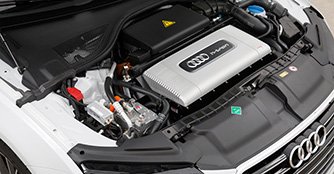Audi A7 Sportback h-tron quattro concept debuts in Los Angeles
23 Nov 2014|2,507 views
Audi's fuel cell technology expertise reaches a new level as it showcased its new A7 Sportback h-tron quattro concept at the 2014 Los Angeles Motor Show. The 'h' in the name h-tron denotes the chemical element hydrogen. In visual terms the A7 Sportback h-tron quattro basically resembles the production model.

It has a lithium-ion battery on board that can be recharged from the power socket by lead; with an 8.8 kWh energy capacity, it has been adopted from the A3 e-tron. It is located beneath the boot and has a separate cooling circuit for thermal management.
On battery power, the Audi A7 Sportback h-tron quattro covers as much as 31 miles (50km). The battery in the rear of the plug-in hybrid can be recharged by lead.
Depending on the voltage and current rating, a full recharge takes between two hours (industrial power socket at 360 volts) and four hours (domestic power socket at 230 volts).
The battery operates at a different voltage level to the fuel cell. For that reason, there is a DC converter (DC/AC) between the two components. This tri port converter is located behind the stack. In many operating statuses it equalises the voltage, enabling the electric motors to operate at their maximum efficiency of 95 percent.
The four hydrogen tanks can store around five kilograms of hydrogen at a pressure of 700 bar - enough to drive for around 310 miles (500km). According to the NEDC cycle, fuel consumption is roughly one kilogram of hydrogen per 100km - an amount with an energy content equivalent to 32.5km/L combined.
With 540Nm of propulsive power at its disposal, the Audi A7 Sportback h-tron quattro, which tips the scales at only around 1,950kg, races from a standstill to 100km/h in 7.9 seconds. Its top speed is 178km/h - a top figure for its field of competitors. The e-quattro concept requires precise coordination of the electric motors - the technology demonstrator offers a dynamic, stable and high-traction drive that is comparable to a production car with mechanical quattro drive.
Audi's fuel cell technology expertise reaches a new level as it showcased its new A7 Sportback h-tron quattro concept at the 2014 Los Angeles Motor Show. The 'h' in the name h-tron denotes the chemical element hydrogen. In visual terms the A7 Sportback h-tron quattro basically resembles the production model.
A special feature of the A7 Sportback h-tron quattro is its plug-in hybrid concept - this represents a logical evolution from the Audi A2 H2 and Q5 HFC test cars.
It has a lithium-ion battery on board that can be recharged from the power socket by lead; with an 8.8 kWh energy capacity, it has been adopted from the A3 e-tron. It is located beneath the boot and has a separate cooling circuit for thermal management.
On battery power, the Audi A7 Sportback h-tron quattro covers as much as 31 miles (50km). The battery in the rear of the plug-in hybrid can be recharged by lead.
Depending on the voltage and current rating, a full recharge takes between two hours (industrial power socket at 360 volts) and four hours (domestic power socket at 230 volts).
The battery operates at a different voltage level to the fuel cell. For that reason, there is a DC converter (DC/AC) between the two components. This tri port converter is located behind the stack. In many operating statuses it equalises the voltage, enabling the electric motors to operate at their maximum efficiency of 95 percent.
The four hydrogen tanks can store around five kilograms of hydrogen at a pressure of 700 bar - enough to drive for around 310 miles (500km). According to the NEDC cycle, fuel consumption is roughly one kilogram of hydrogen per 100km - an amount with an energy content equivalent to 32.5km/L combined.
With 540Nm of propulsive power at its disposal, the Audi A7 Sportback h-tron quattro, which tips the scales at only around 1,950kg, races from a standstill to 100km/h in 7.9 seconds. Its top speed is 178km/h - a top figure for its field of competitors. The e-quattro concept requires precise coordination of the electric motors - the technology demonstrator offers a dynamic, stable and high-traction drive that is comparable to a production car with mechanical quattro drive.
Latest COE Prices
September 2025 | 1st BIDDING
NEXT TENDER: 17 Sep 2025
CAT A$107,889
CAT B$127,501
CAT C$71,556
CAT E$127,901
View Full Results Thank You For Your Subscription.

























